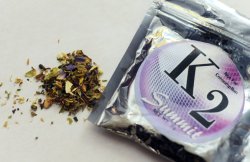New England Journal of Medicine: use of synthetic pot is on the rise, and it poses a serious threat to public health

The Not-So-Nice Spice
Use of synthetic pot is on the rise, and it poses a serious threat to public health.
In the opening weeks of July, 2015, New York City saw over 600 emergency visits for serious, poisonous reactions to smoking synthetic marijuana – also known as K2, Spice, fake pot/weed, Green Giant, Geeked Up, AK-47 and other colorful names. April through June of this year in the city saw a tenfold increase from the same period last year.
Synthetic marijuana is made of dried plants (like oregano or basil) sprayed with a variety of chemicals that when smoked bind to the same brain (and other organ) receptors as does cannabis.
Also called synthetic cannabinoids, when inhaled they produce immediate and intense mental effects on the user. These drugs are sold in small groceries and “head shops” and labeled as incense, potpourri and herbal mixtures with prices well below those of actual marijuana. Users are told these drugs are “natural” and that they will not be detected on drug screens.
New York Gov. Andrew Cuomo on July 17 issued a notice proposing new regulations to “strengthen [the] fight against synthetic marijuana.” Health advisories to hospitals, clinics, doctors and nurses have stressed the importance of recognizing and controlling the dangerous trend underway.
But the problem is by no means limited to New York. An article published in the New England Journal of Medicine on July 9 reported on widespread clusters, from coast to coast, of severe reactions and deaths from these drugs. Europe has also seen the exploding use of so-called “legal highs” – also called “designer drugs." Compared to cannabis, these synthetics are far more potent because they can bind as much as 1,000 times more powerfully to brain receptors. In addition, their breakdown molecules (metabolites), which are also active in the brain, linger longer than cannabis. And naturally-grown cannabis has an ingredient called cannabidiol, which actually mitigates the psychotic-like symptoms marijuana can sometimes produce; synthetic marijuana lacks this inherent protective agent.
Controlling the explosion of synthetic marijuana abuse will need to take both supply-side and demand-side interventions. On the supply side, the U.S. Drug Enforcement Administration has designated a growing number of the chemicals found in synthetic marijuana as Schedule I controlled substances; this makes them illegal to possess, sell or buy. But makers of the drug are continually changing its makeup to elude law enforcement. And while U.S. labs are making synthetic marijuana, New York state health officials say the drug is also imported in significant amounts from China and Russia.
A state can employ criminal and civil financial penalties as well as short jail sentences for possession, distribution or sale of those drugs that have been prohibited. City, state and other law enforcement personnel can also confiscate substances that have the already designated illegal chemicals – but not the new ones entering the market until they too are identified and prohibited.
On the demand side, we are seeing the use of synthetic marijuana especially among vulnerable individuals and groups. These include people with drug use disorders, with mental illnesses, and those living in group homes and shelters. Poverty fosters the use of these drugs because they are cheaper than marijuana and alcohol. ($5 can buy a bag that can be rolled into a number of cigarettes/joints.) Demand reduction is therefore difficult.
But peers, people with drug and mental disorders who are into their own recovery, warning those at risk to smoke “fake pot,” are apt to be more effective than health or mental health professionals. We know, as well, from long experience with demand reduction for tobacco that persistent, highly negative advertising (exposure) is needed to curtail use. The more upsetting the material, the more effective it is. Thus, we will have to employ frightening, even disgusting, images and stories of the consequences of synthetic marijuana to discourage its use.
(...omissis...)
copia integrale del testo si può trovare al seguente link:
http://www.usnews.com/opinion/blogs/policy-dose/2015/08/05/synthetic-marijuana-is-much-worse-than-weed-and-its-a-public-health-threat
(Articolo pubblicato dal CUFRAD sul sito www.alcolnews.it)
